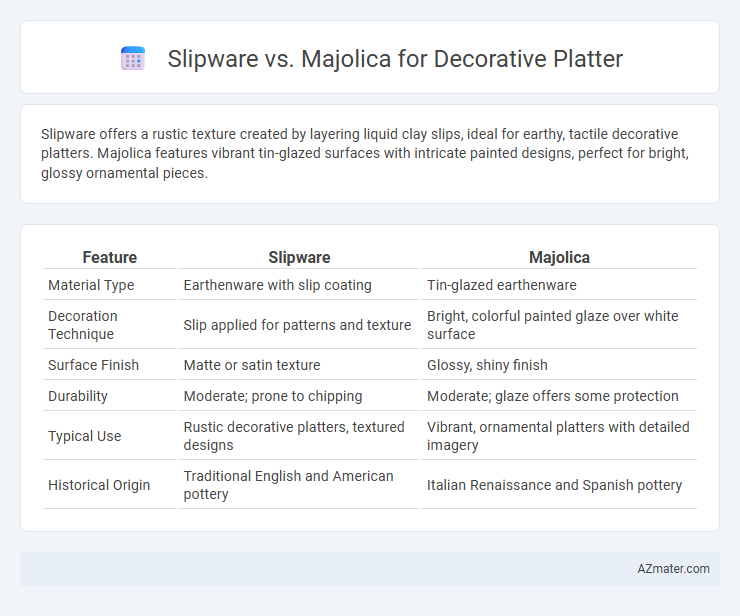Slipware offers a rustic texture created by layering liquid clay slips, ideal for earthy, tactile decorative platters. Majolica features vibrant tin-glazed surfaces with intricate painted designs, perfect for bright, glossy ornamental pieces.
Table of Comparison
| Feature | Slipware | Majolica |
|---|---|---|
| Material Type | Earthenware with slip coating | Tin-glazed earthenware |
| Decoration Technique | Slip applied for patterns and texture | Bright, colorful painted glaze over white surface |
| Surface Finish | Matte or satin texture | Glossy, shiny finish |
| Durability | Moderate; prone to chipping | Moderate; glaze offers some protection |
| Typical Use | Rustic decorative platters, textured designs | Vibrant, ornamental platters with detailed imagery |
| Historical Origin | Traditional English and American pottery | Italian Renaissance and Spanish pottery |
Introduction to Slipware and Majolica
Slipware features a rustic appearance created by applying liquid clay slip to earthenware before firing, resulting in textured, often earthy-toned surfaces ideal for decorative platters. Majolica, by contrast, is characterized by its vibrant tin-glazed finish that produces a glossy, colorful surface with intricate painted designs, commonly used on ornamental ceramic plates and platters. Both techniques offer unique visual aesthetics: slipware emphasizes natural, tactile qualities while majolica showcases bright, detailed artistry.
Historical Origins and Evolution
Slipware originated in the Neolithic period, gaining prominence in medieval Europe through the application of liquid clay slip to create intricate patterns on pottery. Majolica, developed during the Renaissance in Italy, features a tin-glazed surface that enhances bright, opaque colors and detailed painted designs. Both techniques evolved to meet decorative and functional demands, with slipware emphasizing tactile texture and majolica showcasing vibrant, glossy finishes ideal for ornamental platters.
Materials Used in Slipware vs Majolica
Slipware is crafted using a porous earthenware clay body coated with a liquid clay slip, which often contains iron or other metallic oxides, creating earthy and rustic textures after firing. Majolica, on the other hand, involves a white tin-glazed earthenware base, coated with an opaque glaze that provides a bright, glossy white surface ideal for vibrant painted decoration. The distinct materials in slipware emphasize natural, muted finishes, while majolica's tin glaze offers a smooth, reflective canvas enhancing colorful, intricate designs on decorative platters.
Key Techniques and Crafting Processes
Slipware decorative platters utilize a technique where liquid clay slip is applied to the surface before firing, allowing for intricate patterns created by layering or carving through the slip. Majolica involves tin-glazing earthenware with a white opaque glaze, followed by hand-painting vibrant metal oxide colors that fuse into the glaze during a second firing. The slipware process emphasizes texture and relief through slip application, while majolica is distinguished by its glossy, brightly colored surface achieved via tin-glaze and detailed brushwork.
Color Palettes and Surface Decoration
Slipware decorative platters showcase earthy, muted color palettes achieved by applying liquid clay slips in natural tones like ochre, brown, and cream, often creating intricate patterns through sgraffito or trailing techniques. Majolica platters stand out with vibrant, glossy surfaces adorned in bright hues such as cobalt blue, emerald green, and rich reds, highlighted by tin-glazed earthenware that offers a smooth, reflective finish. The surface decoration of slipware emphasizes textured, layered designs rooted in traditional folk art, while majolica features bold, painterly motifs inspired by Renaissance and Mediterranean aesthetics.
Durability and Functional Qualities
Slipware platters offer notable durability due to their thick slip coatings, which provide resistance to chipping and surface wear, making them ideal for regular use. Majolica platters, characterized by their vibrant tin-glaze finish, are more prone to scratching and require gentle handling to maintain their decorative appeal. When selecting between the two, slipware's robustness supports functional longevity, while majolica excels in ornamental vibrancy but demands more careful maintenance.
Design Motifs and Artistic Styles
Slipware decorative platters feature fluid, earthy design motifs characterized by swirling patterns and abstract lines created through slip trailing and sgraffito techniques. Majolica platters display vibrant, colorful artistic styles with intricate floral and figurative motifs, enhanced by a tin-glazed, glossy surface that highlights detailed brushwork and raised relief elements. The contrasting artistic styles emphasize slipware's rustic, tactile textures versus majolica's bright, precise, and ornate designs.
Collectibility and Market Value
Slipware decorative platters, characterized by their slip-trail designs and earthy tones, generally attract collectors who value traditional folk art and regional pottery styles, often commanding moderate market value depending on age and provenance. Majolica platters, known for their vibrant, glossy glazes and intricate relief patterns, hold higher collectibility within antique and art pottery markets, especially pieces from renowned 19th-century European manufacturers, often achieving premium prices at auctions. Market value for both types increases with rarity, condition, and maker's reputation, but Majolica typically outperforms Slipware in high-end decorative platter segments.
Popular Uses for Decorative Platters
Slipware and majolica are both popular choices for decorative platters, each offering unique aesthetic qualities. Slipware features earthy, rustic designs achieved through slip decoration, making it ideal for traditional or farmhouse-style displays. Majolica is known for its vibrant, colorful glazes and intricate patterns, perfect for creating eye-catching centerpieces in Mediterranean or eclectic decor.
Choosing the Right Style for Your Decor
Slipware offers a rustic, earthy charm with its flowing, hand-applied slip designs that complement farmhouse and eclectic decor styles, while Majolica features vibrant, glossy glazes and intricate patterns perfect for Mediterranean or vintage-inspired interiors. Selecting between Slipware and Majolica depends on your decor's color palette and texture preferences, with Slipware providing softer, muted tones and Majolica showcasing bold, lustrous finishes. Consider the visual impact and thematic harmony; Slipware adds artisanal warmth, whereas Majolica serves as a vivid focal point in decorative platters.

Infographic: Slipware vs Majolica for Decorative platter
 azmater.com
azmater.com